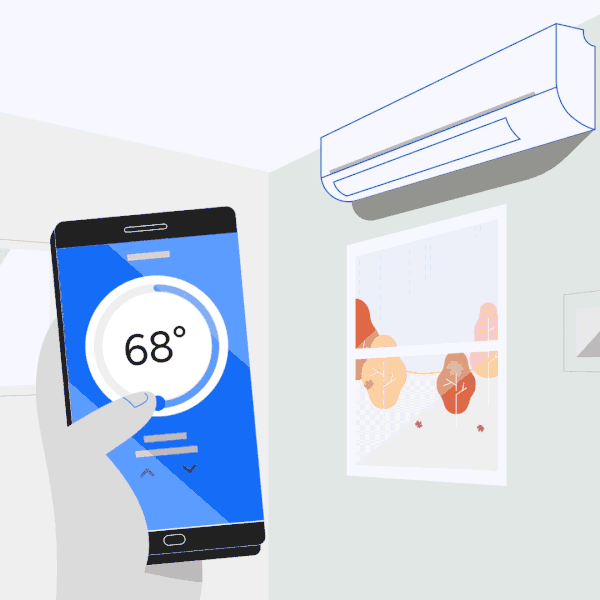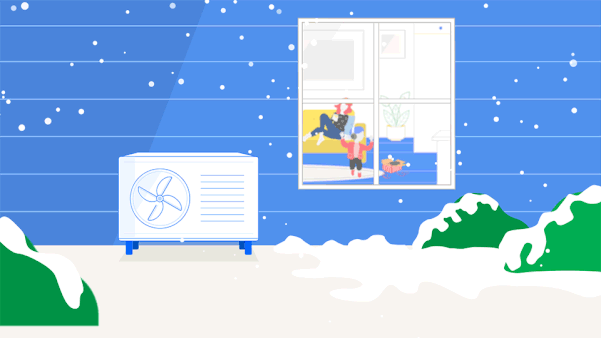Heat pumps are designed to keep going strong when temps drop. If yours is struggling, this guide will help.
There’s nothing like feeling the comfort of a perfectly-heated house during the winter.
But there’s also nothing like feeling frustrated when your heat pump heating system fails to keep your house warm in cold temperatures.
That unwelcome chill in the air might leave you wondering, “Why is my heat pump struggling to keep up when it’s cold outside? Should I switch to a gas furnace or a boiler?”
Don’t panic. Heat pumps are the most efficient HVAC systems available—and they’re more than equipped to handle winter temperatures.
That said, if your heat pump is struggling in the cold, we can help you figure out what’s going on.
(At Sealed, we diagnose and treat home heating issues all the time, so rest assured: You’re in the right place. We’re heat pump experts! And you can get home energy upgrades, including a new cold-climate heat pump and insulation upgrades, with an energy-savings guarantee if you qualify. Tap here to learn more.)
Ready to get warm again? Let’s get started.
Table of contents:
- Do heat pumps struggle in cold weather? (They’re not supposed to! Here’s why.)
- Common heat pump problems
- Troubleshooting heat pump problems in winter
- A professional analysis of heat pump cold weather issues
- Fix your cold weather heat pump problems—and get a home that feels incredible
Key points:
- Cold-climate heat pumps are built to reliably and efficiently heat your home in cold weather. Some models are rated down to as low as -22 degrees (1).
- Heat pumps are the most efficient way to heat a home, but if you have a poorly insulated house, you may not be keeping that paid-for heat inside, which can cause any heating system to struggle. Insulation tax credits and rebates can help you save money on much-needed insulation upgrades.
- If you have an older heat pump system that’s struggling, it may be time for a replacement. Heat pump tax credits and rebates can help offset the costs. And if your house qualifies, you could get a powerful new cold-climate heat pump (and insulation upgrades if you need them) with a energy-savings guarantee and flexible payment options. Learn how.
Do heat pumps struggle in cold weather?
Let’s get one thing straight: Heat pumps can more than handle winter weather—even in very cold climates.
In fact, an air-source heat pump can perform well below temperatures of -13 degrees Fahrenheit! And some newer heat pumps can handle temperatures as low as -22 degrees (2).
Basically: Heat pumps are the most efficient heating option available worldwide.
They have been proven to be twice as efficient as gas and electric heating in sub-zero conditions, and are popular in countries such as Finland and Norway, which have Arctic Circle temperatures.
(Read more about the science of heat pumps in cold weather.)
So the obvious question here is: If heat pumps are so great in cold weather, why on earth is your heat pump failing to heat your home?
If you have a poorly insulated house, you may not be keeping your paid-for heat inside, which can cause your heat pump to struggle.
Common heat pump problems—Here are the common reasons your heat pump might be struggling
Let’s cover some major reasons that your heat pump isn’t getting your house completely warm:
- Snow or ice is getting in the way
- Thermostat settings keep changing
- Your heat pump was improperly installed
- An incorrect size or model is being used
- Old age
- It needs repair or maintenance
- Insufficient home insulation is causing heat loss
- Home air leaks are causing loss of paid-for heat
1. Your outdoor heat pump unit is covered with snow or ice
Heat pumps work by extracting heat from the outside air (yes, even in winter!). So if you live in a region that gets snowstorms and your outdoor unit is covered with ice or snow, your heat pump may struggle to extract heat as the outdoor temperature plunges.
Remember to keep it clear for efficient functioning. (An experienced heat pump HVAC installer will know exactly how to position your heat pump if you live in a colder climate to avoid this issue entirely.)
2. You’re constantly fiddling with your thermostat settings
We get it. You like it at 72 degrees in winter, your partner likes it at 68… and before you know it, an all-out thermostat war breaks out.
It’s tempting to fiddle with the thermostat (or to try to save on energy bills by turning your heat pump off and on again!), but heat pumps work best and are most efficient when they’re allowed to run constantly at the same temperature (3).

Nearly half of Americans admit to fighting with their partner over thermostat settings.
Sealed Survey
3. Your heat pump was incorrectly installed
This is a real bummer, but sometimes heat pumps are installed incorrectly.
That is, they’re installed without proper adherence to technical instructions or are installed by folks who weren’t trained on how heat pump systems should be set up (especially for cold climates!).
A poorly-installed heat pump can have major effects on your home’s comfort.
Tap here to see signs of improper heat pump installation (with examples!).
4. Your heat pump isn’t the right kind
Heat pumps come in different sizes and power levels. Some heat pumps only work well down to about freezing temperatures—and they’re great if you live in, say, Miami.
But if you live in upstate New York or Minneapolis, you definitely need a heat pump that’s rated for winter weather.
Those heat pumps are called cold-climate heat pumps. And if you don’t have a cold-climate heat pump, your system won’t work well in sub-freezing temperatures.
5. Your heat pump is too old
Just like everything else in life, heat pumps have a lifespan.
Heat pumps are hardy, reliable HVAC systems that can last 20 years or more, depending on the model, how well it’s maintained, and if your house is well-insulated and air sealed (4).
But if your heat pump is 10-15 years or older, it’s likely time for an upgrade.
Why? Lifespan isn’t the only issue.
Heat pumps have gotten much better over the years—especially in cold climates—so the capability of outdated models simply can’t match the heat pump technology of today.
6. Your heat pump has a repair issue (or it hasn’t been maintained regularly)
If your heat pump is malfunctioning, a quick maintenance check might do the trick. Even the most dependable heat pump isn’t immune to aging or neglect.
Over time, wear and tear can reduce efficiency, and skipping regular maintenance like filter changes, coil cleanings, or refrigerant checks is like ignoring the Check Engine engine light on your car.
If your heat pump hasn’t had regular tune-ups and HVAC service from an HVAC technician with expertise in heat pumps, it’s no wonder it’s struggling to keep you warm.

7. Your house isn’t insulated well
Insulation is like a snug winter coat for your home. Just like you’d feel the chill if your coat was thin, any heating system is going to struggle if your home’s insulation is lacking.
If heat is escaping through walls, windows, and the attic, your heat pump is going to have to work double-time just to keep up.
Boosting your insulation is like giving your home a warmer coat—and making your heat pump’s job a whole lot easier.
(Related read: 9 signs your house is wasting energy)
If heat is escaping through walls, windows, and the attic, your heat pump is going to have to work double-time just to keep up.
8. Your house is full of holes
Sounds dramatic, but it’s a common problem: Many houses in the US are just full of gaps—around windows and doors, in the foundation, and around your light fixtures.
In fact, ENERGY STAR estimates that air leakage is responsible for wasting up to 40% of the energy you purchase for heating and cooling your home (5).
Air leaks are like invisible open doors, allowing cold air to sneak in and heat to slip out. And that situation forces your heat pump to run a marathon just to maintain a comfortable temperature. (Goodbye, energy efficiency…)
Check out this video below for a quick visual of how air is getting into your house:
Sound intimidating? Don’t worry. We’re about to talk about troubleshooting.
Why can’t my heat pump keep up? Troubleshooting common heat pump cold weather problems
Ready to do some heat pump troubleshooting?
Here’s a step-by-step guide to why your heat pump struggles in cold weather.
- Give your operating manual a once-over: The owner’s manual for your heat pump has some pretty useful information regarding how to get the most out of your HVAC situation.
It’s not exactly a beach read, but trust us: It’s worth a scan if your heat pump is acting up.
(Can’t find the owner’s manual? No worries. Googling “owner’s manual” + “<name and model of your heat pump>” usually turns up the digital copy.)
- Set it and forget it. Ask yourself the simple question: “Is my household using the heat pump correctly?” Heat pumps work best when the thermostat is set at a constant temperature.
Keep the thermostat set on an even, constant temperature for optimum performance and efficiency, rather than turning it off and on with shifting weather.
It is important for everyone in the house to know that turning your heat pump system off and on (or regularly changing the temperatures throughout the day) can cause it to work harder and less efficiently.
(Read how one couple learned this lesson the hard way.) - Inspect and clean or replace the air filters: Dirty filters are like a roadblock for airflow, messing with your heat pump’s efficiency. So how do you know if yours needs to be replaced? The simplest way is to take a look at your calendar—every heat pump is different, but most have filters that should be replaced every 90 days (6).
- Look for debris near the outdoor unit: Check the outdoor heat pump condenser unit. Debris blocking your heat pump can really impede airflow and affect operation. If your outdoor unit is looking crowded (with buildup of snow, leaves, branches, aging lawn furniture, etc.), it’s time for a quick clear out.
- Check the defrost cycle: No one wants a frozen heat pump! Your heat pump has a built-in defroster to keep ice from building up on the outdoor unit and compressor. If this cycle is out of whack, your heating could suffer.
The easiest way to check if your heat pump is defrosting correctly? Pull out your owner’s manual and a timer. A struggling heat pump will often run the defrost cycle way too frequently. So if your heat pump goes into defrost mode more often than the manual says is normal, something is definitely off. - Look for air gaps. Everything looks fine with the heat pump itself? In that case, it’s time to expand the scope of the search and check how well your house is equipped to keep heat inside. (If your house can’t keep heated air from escaping, even the best HVAC on the planet will look ineffective!)
That means it’s time to look for air leaks in your house. This is a bit of a process, so the best way to start is to head over to our guide to a DIY air leak test.
(Related read: How to fix a drafty house)
And after you’ve finished with that…
- Check your insulation. This one goes hand-in-hand with #6, because most American houses have both an air leakage problem and an under-insulation problem. That said, under-insulation can be harder to diagnose if you’re not used to looking at insulation.
Our best advice: If you’ve got an attic, a crawlspace, or both, grab a flashlight and focus your inspection energy in those places. Tap here to learn when it’s time to update your insulation.
The first order of business is to see whether your attics and crawl spaces are insulated at all!
Many aren’t, and if that’s the case in your house, it’s a big reason why your house doesn’t stay warm, why your floors are cold, and why your heat pump can’t keep up with plunging temperatures.
If you do have insulation, make sure to take a close look at the insulation itself. If it looks old and ugly, that’s a decent indication that it’s not doing its job well either.
(This is, in fact, one of those cases where it’s okay to be judgmental about surface appearance.)
Can’t tell how the insulation looks—or are confused by what you see? That’s normal.
In fact, while you can certainly start the process of checking for air gaps and insulation issues by yourself, these tasks are jobs best done by professionals who have seen thousands of homes and know what to look for.
QUICK FACT: Attics need 10 to 14 inches of insulation.
ENERGY STAR
Okay! That’s a lot of steps, but after you complete them you should have a better understanding as to why exactly your heat pump won’t keep up.
Of course, there’s also a good chance that reading all of those steps is flat out intimidating. In which case, allow us to (very humbly!) offer an overview of what we usually see in houses like yours.
A professional analysis of heat pump cold weather issues
Here’s where we level with you as energy and HVAC experts:
When we see a heat pump that never seems to provide enough heat when the outside temperature plunges, the problem is almost always directly traceable to one or both of two issues:
1. The heat pump isn’t the right kind of heat pump or was installed incorrectly
In brief, you either don’t have a modern cold-climate heat pump, or you do and the installation wasn’t done correctly. Both issues are common—and a bummer.
2. The house isn’t keeping outside air outside
Most of the houses we diagnose have both an insulation and an air leakage problem. This is especially true in houses that were built before 2005—that is, before energy-efficiency tactics were common in building requirements.
However, you can have a brand-new build that isn’t properly insulated, either (ask us how we know!)
If your cold-climate heat pump appears to be working correctly but still isn’t heating your home well, the problem likely isn’t with your heat pump, it’s with your house. (Have a large, old house that’s impossible to heat? You know what we’re talking about.)
So—the important question—if these two factors are your problems, what’s the best way to fix them? Do you need a heat pump repair? A completely new system?

Sealed’s crew was able to seal my house and reduce my leakage by nearly half…. Highly recommended!
Jeff H., Sealed customer
The best answer is that you need a home comfort plan based on your house’s unique challenges—and designed by a home performance professional.
And getting that home comfort plan is likely a lot easier than you may think.
Fix your cold weather heat pump problems—and get a home that feels incredible. (Results guaranteed.)
Tired of an uncomfortable, wasteful house?
There’s a better way to live. We’re home heat pump and energy-efficiency experts. In fact, heat pumps are the only HVAC systems we’ll install (we believe in them that much!).
Get powerful home energy upgrades with Sealed, and we’ll handle everything with white-glove service—from installation and cleanup to rebate research for your project and finding the right expert for the job.
And with our flexible payment options, you can choose a way to pay that works for your budget.
Better yet? Eligible households get an energy-savings guarantee on their upgrades. That way, you get smart efficiency upgrades and peace of mind.
If you don’t save energy, we take the hit… not you.
See if you qualify to work with Sealed.
Sealed is really wonderful to work with. They are true professionals who work with you on every detail.
Mark T., Sealed customer